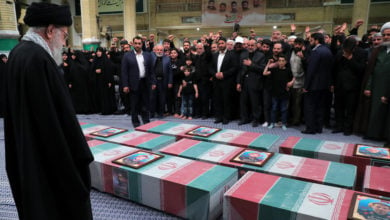In an unprecedented revolutionary wave, uprisings are
breaking out in every corner of the Middle East. Oppressed people throughout
the Arab world, enraged by massive poverty, high prices for essential goods and
widespread unemployment, are rising up against corrupt, U.S.-backed
governments.
These revolts are inspired in large part by the
revolutions in Tunisia and Egypt. On Jan. 14, Zine El Abidine Ben Ali, the
U.S.-backed dictator of Tunisia, fled the country following weeks of mass
demonstrations and over 200 deaths. Following the example of the Tunisian
people, Egyptians took to the street on Jan. 25. After 18 days and 365 deaths,
U.S.-client dictator Hosni Mubarak was forced to resign.
Even before the Egyptian revolution began, thousands in
Yemen began protesting to demand the ouster of Ali Abdullah Saleh, the
president of Yemen for 33 years. Since Feb. 11, demonstrations have been
occurring every day. Pro-Saleh mobs, largely composed of plain-clothes police
officers, have attacked protesters, leaving over 10 dead.
The United States has been bombing Yemen with Saleh’s
approval since at least 2009, ostensibly to combat Al Qaeda. An insurgency waged
by the Houthi tribe is ongoing in the north and a strong secessionist movement
is gaining momentum in southern Yemen, which was a socialist state before 1990.
In a bid to diffuse tensions, Saleh has promised not to run in the 2013
elections or hand power to his son, but this announcement failed to placate the
protesters. Two protesters were shot and killed in Aden, Feb. 16.
In Jordan, a coalition of organizations including the
Muslim Brotherhood and the Jordanian Communist Party has been organizing
demonstrations of thousands every Friday since Jan. 28. The U.S.-client King
Abdullah II bowed to popular pressure and dismissed the government of Prime
Minister Samir Rifai on Feb. 1. However, protests have continued even after
Rifai’s replacement, Marouf al-Bakhit, took office.
Some of the most intense demonstrations have taken place
in the island nation of Bahrain, where a Sunni monarchy rules over a majority
Shi’a population, joined by a large population of non-Bahraini workers.
Bahrain is home to the U.S. Navy’s Fifth Fleet,
which is instrumental to the imperialist strategy for dominating the Persian
Gulf. While most protesters are demanding only a change in government and an
end to anti-Shi’a discrimination, many have begun calling for the end of the
monarchy as deadly repression mounts.
The uprising began with a “Day of Rage” on Feb. 14. The
next day, security forces used live ammunition to disperse a funeral procession
for a demonstrator murdered by the police on Feb. 14. The focal point of the
demonstrations then shifted to the Pearl Roundabout, a large open area in
Manama, the capital. Thousands of protesters occupied the landmark, hoping to
replicate the tactics of the Egyptian people in Tahrir Square.
A pre-dawn raid on Feb. 17 killed at least six and forced
protesters from the square. However, even after the army began patrolling the
capital, demonstrations continued and on Feb. 19 protesters recaptured the
Pearl Roundabout. The General Federation of Trade Unions, the main union
federation in Bahrain, called for an indefinite general strike starting Feb.
20.
In Iraq, a country still occupied by 50,000 U.S. troops,
mass demonstrations have spread against the corrupt government of Nuri
Al-Maliki, protesting the lack of basic services such as electricity and clean
water.
The first large demonstration occurred when thousands of
protesters in the city of Kut stormed a municipal government building and
burned down other symbols of the proxy regime, including the provincial governor’s
residence. Security forces killed three demonstrators, including a 16-year-old.
Demonstrations then broke out in the northern Kurdish
region of Iraq, where police murdered two protesters while a march of more than
1,000 widows and orphans took place in Baghdad on Feb. 19. A demonstration near
the Green Zone billed as the “Revolution of Iraqi Rage” is planned for Feb. 25.
Protests have occurred even in countries thought to be
immune from unrest. In Morocco, clashes broke out with police on Feb. 19, the
day before a march of over 5,000 people that denounced poor economic conditions
and the lack of health care and education.
In the tiny nation of Djibouti, thousands rallied to call
for the ouster of President Ismail Omar Guelleh.
In Kuwait, over a thousand “stateless” people held a
demonstration demanding citizenship before being brutally dispersed by police.
They are mostly Bedouins whose families did not register with the Kuwaiti
government after a nationality law was passed in 1959.
Historic uprisings
an example for people around the world
These uprisings are truly historic and are transforming
the political landscape of the Middle East. After a decade of the so-called War
on Terror aimed at dominating the region, the Arab people are rising up against
U.S.-supported dictatorships. Despite hypocritical calls by the State
Department for “restraint,” the U.S. government is doing everything it can to
stop or co-opt this revolutionary wave.
Attempts to impose a non-class narrative on the uprisings,
claiming that protesters are simply demanding universal human rights, obscure
their anti-imperialist character. The people of the Middle East are indeed
demanding political freedoms and economic justice, but these rights are denied
in large part because of the stranglehold that imperialism has on the region.
The unfolding revolutions in the Arab world aim at overthrowing the comprador
bourgeoisie that has sold the region’s sovereignty to the West.
There have also been demonstrations in countries that are
not U.S.-client states, which have exercised various degrees of independence
from imperialism. As these states have differing characters, the movements
against them should be analyzed separately. The PSL will endeavor to do so as
soon as information becomes available on which to base an analysis.
Poor and working people in the United States face many of
the same problems that provided the immediate spark for the revolts in the
Middle East—unemployment, police brutality and inadequate social services. Media
fearmongering about Islamist takeovers or general “chaos” is simply a desperate
attempt to prevent the U.S. working class from following the lead of our
sisters and brothers in the Arab world. The uprisings in the Middle East stand
as an important example for oppressed people everywhere.






